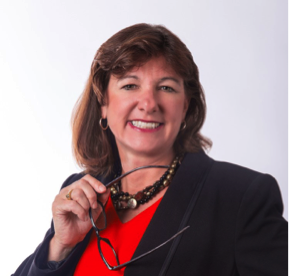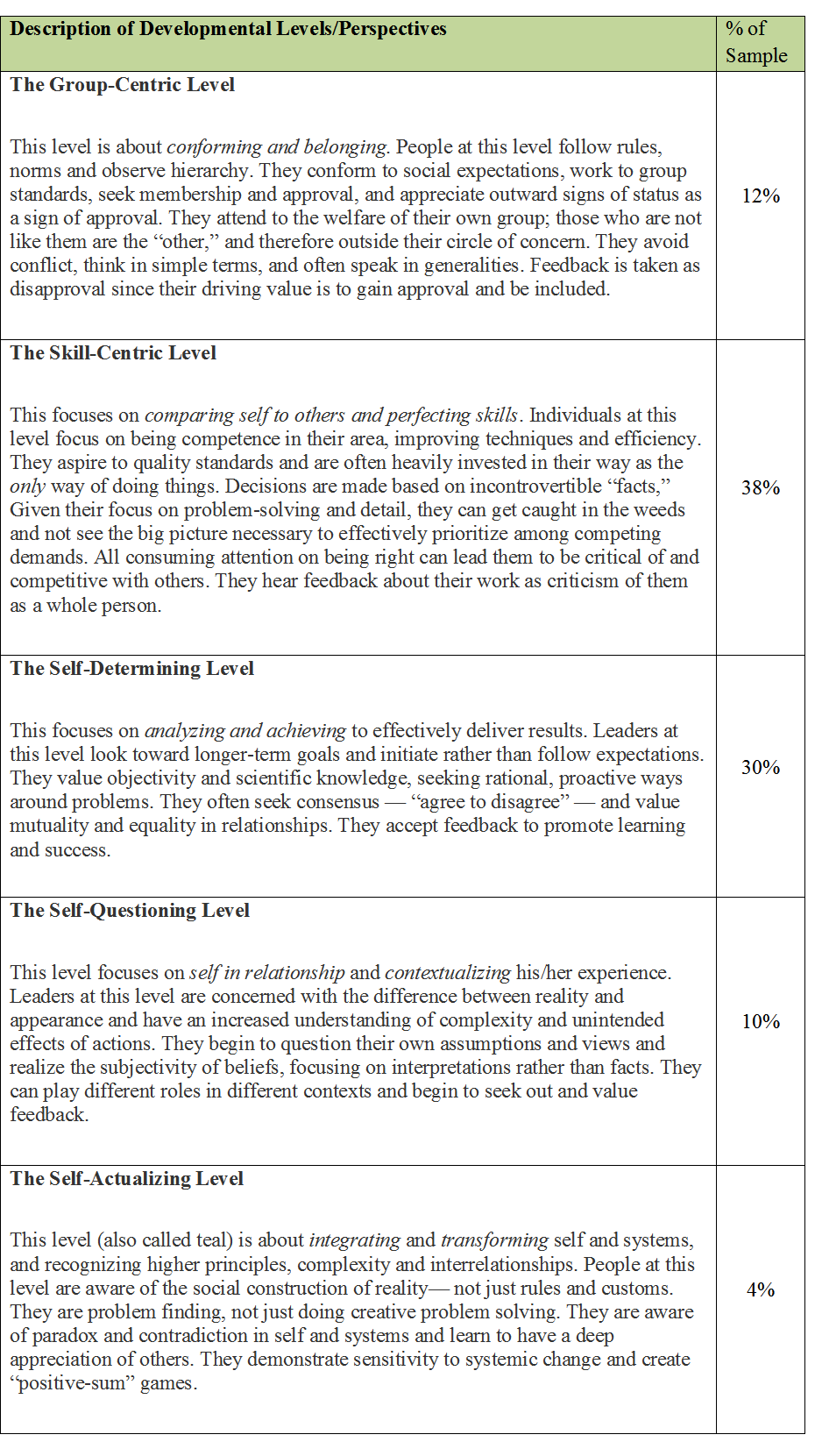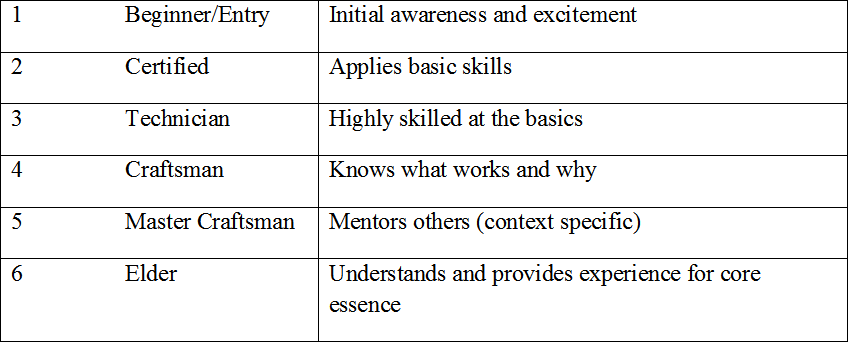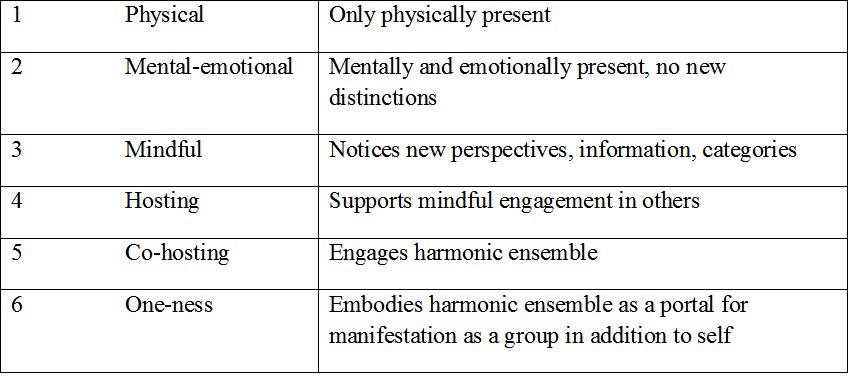Jim Ritchie-Dunham and Maureen Metcalf

Jim Ritchie-Dunham
This paper provides a high-level framework for leaders to refine their approach to increasing team effectiveness by leveraging the concept of “room to roam.” Room to roam looks at five key variables we believe are foundation when looking at leadership successful performance in groups. For people working in groups, we have often seen the group perform to the level of the lowest common denominator.

Maureen Metcalf
This article explores the idea that groups can leverage the skills of each individual across five key perspectives and creates an environment in which each participant operates at his greatest level of contribution. We will call this the alchemy of co-hosting, whereby the co-host, in conjunction with the participants, invokes a very different mindset and process for the team to function.
This paper explores each of the five perspectives and sets out a process for co-hosting that creates an environment in which each perspective contributes to a holistic solution.
The Challenge
“Less than one-third of U.S. employees have been engaged in their jobs and workplaces [since 2000]. According to Gallup Daily tracking, 32% of employees in the U.S. are engaged — meaning they are involved in, enthusiastic about and committed to their work and workplace. Worldwide, only 13% of employees working for an organization are engaged.” – Gallup
Much of our work is done within teams comprised of many highly effective and highly compensated people. We have found that these teams often function at the level of the least common denominator. Many people, especially leaders, move from meeting to meeting all day, every day. They often do this with little awareness of the specific role they play in the meeting and the value they bring. This is the culture of many organizations. When asking a cohort of vibrancy community members what they experienced in these teams, they suggested that while the participants were generally strong employees with good skills, they were often disengaged and some actively disrupted the work or found ways to interfere with the meeting goals. In some cases, the participants did this as passive aggressive response and in some worse cases, did it just for personal entertainment. So, what is the antidote to this high level of disengagement considering five key factors rather than the highest-level present? How do we capture the highest level of input from each person to create a higher-level “field” of operation than any individual would have access to working alone?
The approach
We look at five different perspectives or measures of intelligence then explore how the art of co-hosting can leverage all five intelligences of the participants to create an environment that calls forth the greatest possible capacity.
The five perspectives are:
- Leadership maturity
- State development
- Years of experience
- Skill to identify the perspectives in the room
- Co-hosting skill – the ability to identify the perspectives in the room and create an environment and approach that leverages the maturity, state, and skills
It is interesting to note that each of these perspectives is important for an organization to create holistic solutions to the many complex challenges they face. For that reason, it is important to recognize each of these perspectives and be able to identify, recruit, and create environments that genuinely leverage the gifts of each.
We will explore each of the five perspectives individually then talk about how effective co-hosting can create the “container” or space to leverage each to their highest perspective rather than the traditional lowest common denominator.
Leadership Maturity
Developmental theorists have looked at maturity using a framework that emerged from the field of developmental theory and research. For the purpose of this paper, we are using the work of Dr. Cook-Greuter who developed a Leadership Maturity Framework (LMF) and measurement of adult development as part of her doctoral dissertation at Harvard University. There are levels above and below the ones referenced in the chart, therefore percentage of sample numbers do not add to 100%. The percentages are drawn from the work of Dr. Cook-Greuter and Beena Sharma at the Center for Leadership Maturity. These levels are seen less often in organizational environments. There are a few important elements to mention when referencing developmental maturity:
- People test across a bell shaped curve, so people have access to many levels simultaneously.
- They move through the levels in a pattern we call transcend and include, which means we all start at the earliest level and move through the levels by developing a capacity at each level “mastery” then integrating the perspectives at that level into our being and moving to develop perspectives at the next level.
- Each level has gifts that prepare it to perform certain tasks and roles best. We refer to this as “fit for role.” Organizations and people are most effective when the individual maturity is aligned with the level of maturity required for that role. A simple example is a project manager in charge of multiple large complex projects that require significant trade-offs between time and resources might be an achiever. Earlier levels will not do as well at the trade-offs. We often assume that if a level is a fit, then a later level is better. In many cases the later level person can do the role, but this is not a best fit so the individual may not be challenged and, therefore, may not be as fully engaged.
Leadership maturity is a complex field of study. This overview is intended to provide a very high level summary.

States of Development
The second perspective we want to discuss is access to states of development. People at all levels of developmental maturity (stage) may have access to some or all of the states, i.e. people at the earliest level of leadership maturity may have access to the highest state, non-dual. We refer to gaining access to greater state as waking up. The following chart provides a brief summary of states:

Years of Experience
The third perspective is years of experience. This category captures the wisdom many people develop by virtue of navigating the complexity life brings. For many people, this could include navigating aging and loss of parents, raising children and the challenges and blessings this offers, navigating job loss as organizations change, managing organizational transition, managing marriage and possibly divorce and the many other challenge life presents. While some people do not seem to develop wisdom, many do. Their job titles may not reflect senior accomplishments, but they are notable by the fact that others seek their counsel. They may have a practical wisdom that has allowed them to navigate life. We might say they have “common sense” or that they are wise.
Skill
The fourth perspective is skill. This category reflects the depth of competence an individual gains based on years of practicing his craft. This is interesting because many individuals who are traditionally discounted in leadership discussions may have great insight because of their skill in the work of the organization. An example might be a master engineer who is deeply experienced at designing complex highway systems but inexperienced in the art or practice of leadership might be called upon to help make key organizational decisions because he understands which facets of the organization’s environment promote this level of excellence and which detract from it. We refer to gaining greater access to this category as skilling up. We define the skill levels as:

Mindfulness
The fifth perspective is what we call mindfulness or how we work with the ideas and possibilities in the room. This perspective captures a key part of the “magic” of transitioning from a technician who can run an effective meeting where people show up and efficiently accomplish a task toward the person who can really draw the best from all participants concurrently to solve highly complex problems that require a deeper level of engagement than traditional engagement. We call development along this continuum showing up. The categories are:

And now we explore the “magic”—how to create environments and build the mindful perspective to co-host or operate from a state of one-ness that allows each participant involved to operate from a space of co-hosting. Part of this process involves:
- each participant recognizing their individual contribution to the group and feeling valued for that contribution (and feels good about being able to make that contribution)
- each participant operating from a deep sense of sufficiency (they feel valued by the group and they value others)
- each person believing in the mission of the organization
This is the first part of the magic of creating an environment in which people can give their best. People must be fully engaged to offer their gifts to the group, and the group must respect and appreciate the offering of each participant. The word that comes to mind as I describe this is grace. People operate with inner grace toward themselves and outer grace toward others. The co-host is critical in this process. Unless the co-host is mindful and fully engaging everyone according to their gifts, this level of performance is not possible.
We refer to this as engaging the harmonic ensemble much in the way a master conductor does with an orchestra. The conductor knows what music is being played and understands the gifts of each musician. He invites each participant to contribute to fill their role and also to stop playing to allow others to make their contributions. The mindful co-host uses the same level of skill in conducting an encounter (meeting, gathering, etc.).
One of the key differences between this approach and traditional approaches is the underlying mindset about the people we are engaging. We see them as “homo lumens” or fully complete and even divine beings. Imagine what changes when we assume all of our participants bring towering strengths to the process. This does not mean that they are without fault or perfect in any way. As co-hosts, we focus on inviting their towering strengths and ensuring we create an environment where any associates weaknesses are minimized or managed. For most people with whom I work, when we acknowledge their greatness, much of the dysfunction that comes from fear and attention seeking dissipates so there is not much to manage. It is interesting to see the significant change by just changing our stance or view of each participant.
Co-hosting as a process
Co-hosting is a process that individuals can learn to do. Following are the process steps. What is not captured in this description is the experience of co-hosting that I have called “magic.” It is the experience one has similar to what psychologist Mihaly Csikszentmihalyi calls flow or optimal experience. The co-hosting process involves a structured process, but also a mindset and presence of the co-host that is fully engaged in mind, body, and spirit to create this optimal experience for all of the participants. Without this presence and engagement, what is intended to be co-hosting degrades to simply a highly effective and efficient meeting.
- Identify the topic or issue to address
- Identify what perspectives need to be included in the room
- Identify who holds those perspectives
- Determine if the key perspective holders are called to participate (are they excited about possible involvement)
- Determine the initial structure of the engagement ranging from a single meeting through an ongoing organization
- Invite participants
- Co-host a session to determine agreements about who we are and how we will operate—this step is crucial in setting the tone that everyone is a homo lumens and we treat one another as such
- Co-host ongoing sessions to accomplish the group’s objectives
Summary
During this era of increased complexity, accelerated need for change, it is imperative that we identify methods and processes to help us navigate the challenges we face. Optimally, these methods and processes would create the greatest impact for all involved—creating an optimal experience for the individuals and a holistic solution for the organizations or groups involved.
We believe that the solution integrates a solid process that integrates five key perspectives and a presence of being within the co-host to create the desired outcome. Both elements are critical.
We have an opportunity to enhance the experience and the impact we have in trying to solve problems. By building the capacity to co-host and using this process, we increase the probability of solving our most complex problems and enjoying the process. Knowing that this is possible helps me regain hope that we as a society can resolve the mounting list of intractable problems we hear of every day on the news.
References
O’Fallon, Terri. Collapsing the Wilber-Combs Matrix: The Interpenetration of the State and Structure Stages #itc2010
Cook-Greuter, Susanne. Nine Levels Of Increasing Embrace In Ego Development: A Full-Spectrum Theory Of Vertical Growth And Meaning Making
Metcalf, Maureen. What is the path to Leadership Maturity, Forbes, August 30, 2016
About the Authors
Jim Ritchie-Dunham is president of the Institute for Strategic Clarity, a global research nonprofit, president of Vibrancy Ins., LLC, a global consultancy and publisher, president of the private operating foundation the Academy for Self-Discovery Leadership, an adjunct faculty member in Harvard’s program in sustainability leadership, and Adjunct Professor of Business Economics in the ITAM Business School in Mexico City.
Jim authored Ecosynomics: The Science of Abundance (2014), co-authored Managing from Clarity: Identifying, Aligning and Leveraging Strategic Resources (2001), has written many articles on systemic strategy for academic and practitioner journals, and blogs regularly at jlrd.me. He has a BS in Petroleum Engineering from University of Tulsa, an MIM from Thunderbird, an MBA from ESADE, a PhD in Decision Sciences from University of Texas, Austin, a postdoc in system dynamics and organizational studies from MIT, and a postdoc in psychology and Langer mindfulness from Harvard.
As a student of human agreements, Jim Ritchie-Dunham brings over 25 years of research and insights gleaned from working with groups of all make-ups. Jim named Ecosynomics, the emerging social science of the agreements that guide human interactions. Ecosynomics provides a framework rooted in economics and the sciences of human agreements that begins with an initial assumption of abundance, not scarcity, and a wider view of the human being. He has found that groups that start with this fundamentally different assumption work at greater levels of effectiveness, efficiency, and innovation. As president of Vibrancy, LLC and the Institute for Strategic Clarity, Jim brings together the worlds of research, publishing, consulting, and conferencing to support people in exploring new agreements around large-scale social changes while doing so with higher levels of harmonic vibrancy. Jim supports leaders on a global level in organizations that cross the lines of business, government, and civil society.
Maureen Metcalf, CEO of Metcalf & Associates, is a renowned executive advisor, author, speaker and coach who brings 30 years of business experience to provide high-impact, practical solutions that support her clients’ leadership development and organizational transformations. She is recognized as an innovative, principled thought leader who combines intellectual rigor and discipline with an ability to translate theory into practice in all of her work. Her operational skills are coupled with the strategic ability to analyze, develop and implement successful strategies for profitability, growth and sustainability.
In addition to working as an executive advisor, Maureen designs and teaches MBA classes in Leadership and Organizational Transformation. She is also the host of an international radio show focusing on Innovative Leadership for Voice America, and the author of a nine book award-winning book series on Innovative Leadership, including the Innovative Leaders Guide to Transforming Organizations, winner of a 2014 International Book Award.
Maureen is a valued board member to a number of organizations, and served on the board of trustees for Urbana University. Before founding Metcalf & Associates, she worked for PricewaterhouseCoopers and Accenture across a broad range of industries, building strong business acumen and consulting skills. She has worked with a number of Fortune 100 clients delivering a wide range of significant business results such as: increased profitability, cycle time reduction, increased employee engagement and effectiveness, and improved quality.

Pingback: 11/30 – Mni Wiconi - Water is life! - Integral Leadership Review
Pingback: Recommended Reading — Realizing the Best Conversation Available in the Group « Jim Ritchie-Dunham
Pingback: Maximizing Team Interactions | Metcalf & Associates
Pingback: Metcalf & Associates Recommends Interview: Teams That Cross the Highest Bar - MONEY® News
Pingback: Metcalf & Associates Recommends Interview: Teams That Cross the… – Venture Entrepreneuer